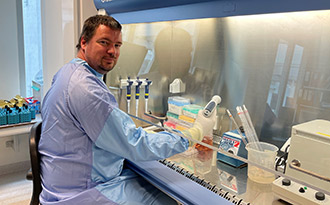amfAR Grants Explore Gene Therapy Approaches to HIV Cure
Research teams deploy powerful CRISPR gene-editing, CAR T cell strategies to home in on HIV reservoir
amfAR has awarded approximately $600,000 in new funding to researchers pioneering gene therapy approaches to target and eliminate the HIV reservoir—the primary barrier to a cure—with far greater specificity than is currently possible.
A major obstacle to an HIV cure is the lack of a biomarker to differentiate reservoir cells from healthy, uninfected cells. In its request for proposals, amfAR charged researchers with devising creative ways of using the provirus—HIV that has integrated into a host cell’s DNA—to flag the presence of HIV and to zero in on reservoir cells. They were also encouraged to target both fully functional proviruses and the vast majority that are defective, since these can lead to inflammation that causes serious health conditions, even if they can’t produce new viruses.

Todd Allen, Ph.D., of the Ragon Institute of MGH, MIT and Harvard, and colleagues have identified a group of antibodies they have called broadly functional antibodies. These bFAbs are adept at binding to infected cells and flagging them for destruction by other components of the immune system such as natural killer (NK) cells. Dr. Allen and his team will test the bFAbs alone and in combination with genetically engineered CAR T cells with enhanced ability to kill infected cells that his team has already designed. The interventions will be tested in HIV-infected mice populated with human immune cells and are designed to target only those cells that are infected with HIV.
CAR T cells have proven highly effective against certain blood cancers, but less so against HIV—partly because they are susceptible to infection and destruction by the virus. Current CAR T cell formulations also require that they are made for each patient as a form of personalized medicine,
contributing to their high cost. A team led by Anastasios Karadimitris, Ph.D., MRCP, FRCPath, of Imperial College, London, plans to address both issues by using cells that combine the characteristics of naturally occurring NK cells and T cells as the basis for their CAR cell therapy. Most invariant (i) NKT cells do not carry the CD4 protein on their surface and thus should be resistant to HIV infection. Unlike conventional T cells, there is little variability in iNKT cells among the human population, so it may be possible to design “off the shelf” CAR-iNKT cells that would work in most people with HIV, rather than having to manufacture CAR T cells from each individual patient.

CRISPR/Cas gene-editing technology has shown breakthrough potential for treating a range of medical conditions. In the field of HIV cure research, the prospect of being able to excise the virus wherever it has inserted itself into host DNA is a tantalizing one. But its delivery remains a challenge. Across the genome there are very tightly wound regions that limit access to the DNA and may prove difficult for CRISPR/Cas to penetrate effectively. Recent evidence shows that HIV sometimes
integrates into these regions. Jori Symons, Ph.D., of University Medical Center Utrecht, and colleagues plan to test whether this explains the resistance of some viruses to excision by CRISPR/Cas. They will attempt to increase the gene-editing tool’s effectiveness with drugs that open up and expose the DNA.
“We’re pleased to be supporting this impressive trio of research teams that are bringing a range of smart, creative approaches to the challenge of curing HIV,” said amfAR Chief Executive Officer Kevin Robert Frost. “We hope these investments generate new insights that will help us develop a curative intervention for all people living with HIV.”
Share This:
